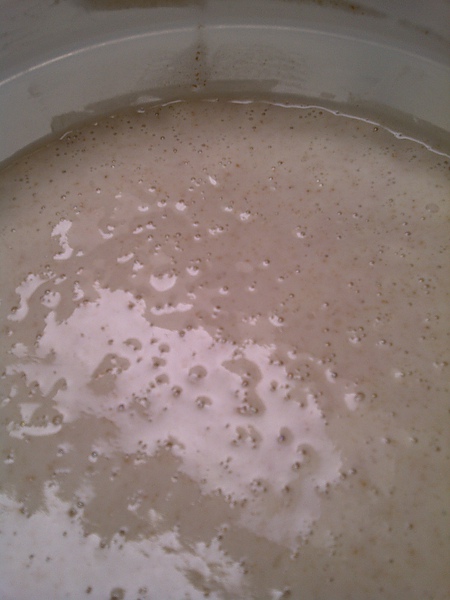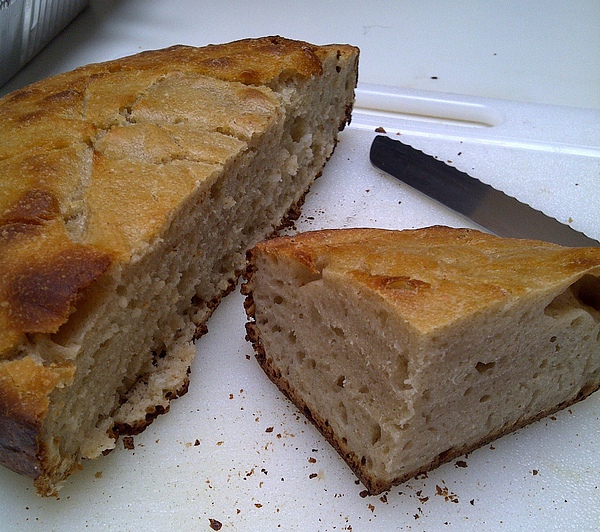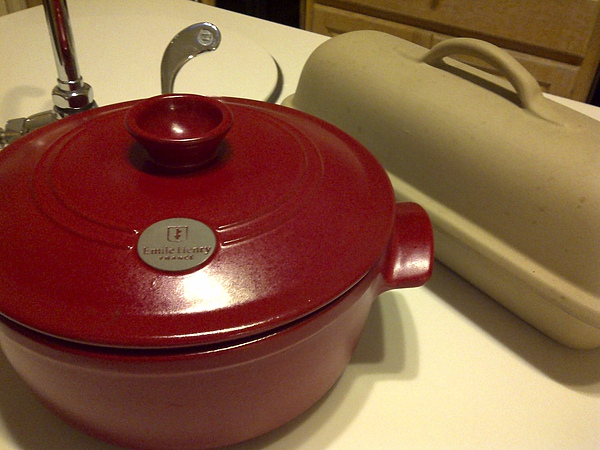Two Sundays ago (10/17/2010) I ran into Mrs. Lee (李基藏牧師娘) in church, and she gave me some of her house farmed grapes. The grapes were deliciously sweet; however, they were a bit small and the seeds were big, so I decided to make better use of them-to grow wild yeast. I've always wanted to try "capturing", "culturing" or "growing" wild yeast for quite some time, but have never been brave enough to start.
Tada! After a week of keeping the yeast alive, I made my first sourdough bread this morning with the wild yeast I harvested last night.

(The one week old wild yeast)
The bread crust was a little burned, but it was very delicious! Crust was crunchy, and the crumb was super moist and tender, much like custard when it was fresh out of the oven!

(My
first bread without any commercial yeast at all!  )
)
-------------------------------------------------------
Here’s my wild yeast sourdough bread diary:
To grow wild yeast (sourdough starter):
I use the following link for guidelines:
http://allrecipes.com//Recipe/wild-grape-starter/Detail.aspx
However, this other link is very good too:
http://www.io.com/~sjohn/sour.htm
It helps me be more confident and be able to better judge the progress.
The grapes I received weighed about 1 1/2 lbs., since this was my first time trying, I used only 1/2 lb. in case I should fail then I still have 1 lb. of these delicious organic grapes to restart. (Oh, I stored the extra grapes in the freezer.)
Ingredients:
1/2 lb. organic grapes
1/2 cup whole wheat flour
Many portions of 1 cup bread flour plus 1 cup water (I used RO filtered potable water)
Instructions:
Day 1: (10/18/2010 Mon)
1. I rinsed and pat dry the grapes. Some said that the white stuff on the grape skin is the yeast, and some said it's the wax. I left it on the grapes anyway.
2. I used a transparent tupperware that holds about 4 cups liquid, and crushed the grapes in it with my clean hands.
3. Then I covered it with a tea towel, and left it in the cupboard in the kitchen.
Day 2: (10/19/2010 Tue)
1. Did nothing except peeping into the cupboard out of curiosity. Saw some bubbles on top of the grape mash, and was happy!
Day 3: (10/20/2010 Wed)
1. It smelled sour, sweet and winy, very pleasant, not foul at all! Yay! And more bubbles! Yay some more! And there was liquid at the bottom in the tupperware!
2. I thought it seemed ready to be "fed" now, so I drained the liquid, cleaned the tupperware, put the grapes juice back in it, and blended in the 1/2 cup whole wheat flour.
3. Covered with the tea towel, and stored it back to the cupboard.
Day 4, 5 ad 6: (10/21-10/23/2010 Thu-Sat)
1. The smell got stronger, almost like wine, so I started to feed it with 1 cup of bread flour and 1 cup of water. Measured them directly into the tupperware, and blended well, and parked it back where it belongs.
2. Some days I saw "hooch" (the dark liquid), and I just blended it back into the batter.
Day 7: (10/24/2010 Sun)
1. One week had gone by, and it seemed like the yeast was growing happily in my cupboard, so I decided that it was time to harvest and make bread!
2. I used the second link to make my sourdough bread.
http://www.io.com/~sjohn/sour.htm
To make wild yeast sourdough bread:
Ingredients:
2 cups sourdough starter (wild yeast batter)
3 cups bread flour
4 teaspoons sugar
2 teaspoons salt
2 tablespoons olive oil (optional)
1/2 - 1 1/2 cups water
Instructions:
1. Forming the dough: Since I have baked homemade breads many times before, I know that the ingredients for these rustic breads are just a guide. I don't always follow them. The main goal is to make a, if not wet, very soft dough.
I used a large mixing bowl for the dough this time. I added everything at once except one cup of bread flour. Then I added some water because the dough seemed dry to me, and then I added all the bread flour called for and added more water until it seemed like very thick batter instead of a dough.
I then oiled a gallon size plastic bag, and put the batter-like dough in it, and let it rise in a warm place. I first followed the instruction in S. John’s website, but since I also needed the oven to bake the sheet cake for petit fours, I moved it on the stove top where is warm when the oven is at work.
2. Proofing the dough: (Letting it rise.) I waited close to 24 hours to let this first sourdough of mine double its volume. It finally came close to double, but not quite. There were many holes on the surface of the dough which I have never seen before in other dough I’ve made. They usually appear to be smooth after they doubled or tripled. I was afraid that the dough would go bad, so I decided to bake it anyway.
3. Baking the dough: There are so many ways in baking the rustic country bread. My preference so far is to use a stoneware in the oven.

(These are my bread baking pots.)
I burned the bottom crust this time because I used the highest temperature to preheat the oven and the pot, and to bake it for the first 20 minutes until I smelled something burning, then I rescued it by lowering the temperature down to 475 F.
Using the stoneware pot to make crusty country bread is something I’ve learned from this video clip:
http://video.nytimes.com/video/2006/11/07/dining/1194817104184/no-knead-bread.html
I did not go through using wheat or corn meals and the towel to make it look nice this time, I just cut open the plastic bag and plop the dough straight into the blazing hot pot, and baked for a total of 30 minutes with first 20 minutes on 550 F and the last 10 minutes on 475 F.
I just watched the video link again right now, and came to realize that I forgot to remove the lid for extra 15 minutes browning the top baking. Do that tomorrow for the next bread then!
----------------------------------------------------------------------------
It was an exciting journey making bread truly from scratch!
I made my second batch of dough this afternoon using the KitchenAid stand mixer with the dough hook, and I used only 1/2 cup of water today so the dough was firmer, only trying to see how it would differ when it proofs, maybe there would not be holes on the surface this time, who knows? Anyway, the “holy” bread was still quite enjoyable!


 留言列表
留言列表
